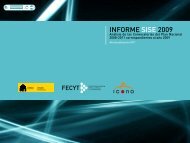BiologÃa Sintética - ICONO
BiologÃa Sintética - ICONO
BiologÃa Sintética - ICONO
Create successful ePaper yourself
Turn your PDF publications into a flip-book with our unique Google optimized e-Paper software.
BIOLOGÍA SINTÉTICA<br />
En 1989 un grupo de investigación suizo creó un<br />
ADN que contenía dos letras artificiales adicionales a<br />
las 4 que existen en la naturaleza. Desde entonces<br />
se han desarrollado distintas variedades de ADN<br />
artificial 14 . Hasta ahora, no se ha conseguido<br />
obtener genes completamente funcionales a partir<br />
de ADN artificial o alterado dentro de células vivas.<br />
Sin embargo, en el año 2003, el grupo de Schultz 15<br />
del Scripps Research Institute desarrolló células<br />
que generaban aminoácidos artificiales que dieron<br />
lugar a nuevas proteínas. Para ello desarrollaron un<br />
ARNt que era capaz de unirse al codón de<br />
terminación TAG y en lugar de finalizar la traducción<br />
del ARN a proteína, incorporaba un nuevo<br />
aminoácido diferente de los 20 aminoácidos<br />
naturales.<br />
Código genético (ARN mensajero)<br />
ARNt<br />
AAA ACC AUU UUU UCC<br />
GGC AUU CAG UAG GUC<br />
Proteína con aminoácidos naturales<br />
Proteína con un aminoácido incorporado<br />
Algunos experimentos de expansión del código genético:<br />
• Instituto Tecnológico de California, Universidad de Massachussets 16 .<br />
• Universidad de Texas, Universidad de Hong Kong 17 .<br />
• Universidad de Munich 18 .<br />
• Instituto de Investigación Scripps 19 .<br />
• Instituto de Genómica de la Fundación de Investigación Novartis 20 .<br />
• Universidad de Florida 21 .<br />
• Universidad Western Washington, Universidad de Yale 22 .<br />
Fig. 2. Expansión del código genético.<br />
Fuente: Bacher, J. M., et al. (2004). Evolving new genetic codes. Trends in Ecology & Evolution, 19: 69-75.<br />
14 Switzer, C. Y., et al. (1989). Enzymatic incorporation of a new base pair into DNA and RNA. J. Am. Chem. Soc. 111,<br />
8322-8323.<br />
15 Laboratorio de Schultz del Scripps Research Institute (http://schultz.scripps.edu/).<br />
16 Kiick, K. L. (2000). Expanding the Scope of Protein Biosynthesis by Altering the Methionyl-tRNA Synthetase Activity of a<br />
Bacterial Expression Host. Angew. Chem. Int. 39, 12:2148-2152.<br />
17 Bacher, J. M., et al. (2004). Evolving new genetic codes. Trends in Ecology & Evolution, 19: 69-75.<br />
18 Böck, A. (2001). Invading the Genetic Code. Science 20 April: 453-454.<br />
19 Xie, J., & Schultz, P. G. (2005). Adding amino acids to the genetic repertoire. Curr Opin Chem Biol. Dec;9(6):548-54.<br />
20 Döring, V., et al. (2001). Enlarging the amino acid set of E. coli by infiltration of the valine conding pathway. Science,<br />
vol. 292, 5516:501-504).<br />
Wang, L. (2001). Expanding the genetic code of E. coli, Science, vol. 292, 5516:498-500.<br />
21 Sismour, A. M. & Benner, S. A. (2005). The use of thymidine analogs to improve the replication of an extra DNA base<br />
pair: a synthetic biological system. Nucleic Acids Res. Sep 28;33(17):5640-6.<br />
22 Anthony-Cahill, S. J. & Magliery, T. J. (2002) Expanding the Natural Repertoire of Protein Structure and Function. Current<br />
Pharmaceutical Biotechnology 3, 299-315 299.<br />
13





